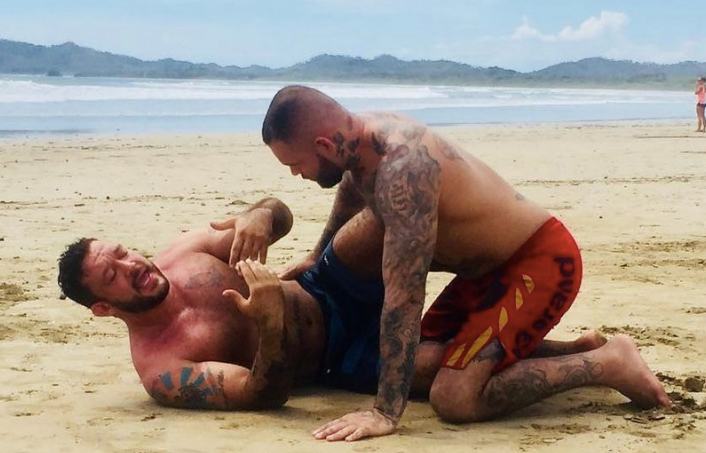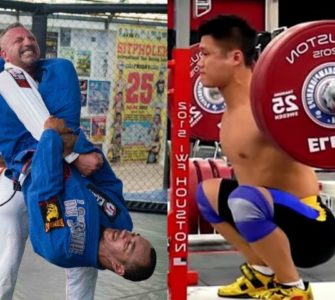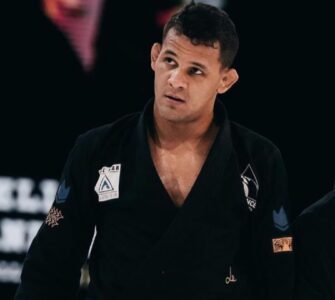It’s no secret that Tom Deblass’ favorite position is the half guard. It’s a position he has been using since he was a blue belt nearly 15 years ago. Since then he has been refining the position on the mats and in the competitive arena against some of the top competitors out there and on grappling’s highest stages. When he’s not on the mats at his own school, traveling around the world motivating students around the globe or competing on the top stages, he’s always thinking about half guard.
For DeBlass, the elements of a strong basic half guard are relatively simply. There is first and foremost the use of one’s legs to control the the leg and hip of the opponent to prevent the guard pass. Most often Tom DeBlass relies on the bottom leg to hook the opponent’s thigh and shin keeping tabs on their whereabouts and keeping them cinched in the half guard, while the top leg is utilized as a knee shield if he’s trying to control distance and keep their pressure and weight away from him.
In some cases that top leg is transformed from a protective knee shield to a more active and in some cases attacking leg. For DeBlass, the knee shield is primarily a defensive posture. When the knee shield is dropped or removed, the opponent can be enticed to come forward, committing their weight to your body and making them easier to sweep.
The arms play a huge role for both top and bottom half guard players as well. For the bottom player looking to be defensive or maintain distance and alleviate pressure, the arm frame across the throat and shoulders will keep them at a distance and at bay. While this top side arm is working as a frame, the bottom arm remains active and protecting against the cross face.
Conversely, when one in topside half guard, they need to be wary of the knee shield and the frames. The goal for the top player is to flatten the opponent’s body, securing under hooks and working to immobilize the hips to prevent them from working their way underneath and reversing you.
Never a fan of days off, Tom DeBlass has shared a game changing half guard tip while on vacation in Costa Rica. In the same vein as his best selling Half Domination series, the clear and concise directives DeBlass shares can be implemented easily and have you dominating your classmates and opponents in no time.
In this video addresses one of the most troublesome spots in bottom half, namely trying to prevent the opponent from securing the under hook and flattening him. In addition, once he is able to secure his own under hook pay special attention to how he does it and how the opponent’s weight and body are directed.
Let’s look at some key principles that Tom DeBlass shares in this video.
Don’t make your bottom half too pushy.
As beginning half guard players and in some cases in more experienced grapplers, for DeBlass, one of the mistakes that can be made is that there’s too much reliance on the knee shield and arm frames in attempting to keep the opponent at a distance.
One of the ironic facts inherent in jiu jitsu is that often times we must embrace the pressure to release or reverse the pressure and this is a great example. It is much harder to reverse the opponent from bottom half if they are kept at a distance and allowed to maintain a strong, heavy base.
In this case, the knee shield must be relinquished. The sense of losing part of our fortifications will take some time to get used to, but this will allow the opponent to push forward with their weight, which is exactly what we need to make the reversal happen.
So don’t let your half guard become too defensive and spend too much of your time PUSHING the opponent away. Instead, recognize that there are times when we must embrace their weight and their pressure to make the techniques work.
Make the under hook disappear.
The primary goal for the top half guard player is to pass the guard. To be able to do this, it is likely that they will need to flatten the bottom player out and immobilize their hips. The way to flatten and control the upper body is to secure an under hook. So as the bottom player, protecting that top side elbow is essential to prevent oneself from being flatted. As Tom DeBlass points out, keeping the elbow glued to the body and the arm in from of the midline of your body will make the possibility of the securing the under hook disappear.
Don’t let your under hook be too shallow.
Once the knee shield is down and the under hook possibility has been removed, the next step is to allow their weight to come forward. This presents a unique opportunity to pop the hand that is being hidden out and around to secure an under hook from the bottom.
For DeBlass, this under hook is extremely important for future reversal attempts and must be executed exactly in the manner described in the video, by reaching for and connecting to the far trapezes muscle of the opponent. By reaching for a deep under hook, you gain much more control, while eliminating the reaction that is common from all players on top which is to whizzer that under hook and attempt to continue flattening the bottom player out.
By following these three simple principles of making sure that you allow yourself to explore a more offensive bottom half guard by knowing when and how to release the knee shield. By coupling this proactive half guard position with a hidden arm that eliminates any chance of the the top player’s under hook from being secured and creating an opportunity for your own under hook to be taken that is both deep and high on the far shoulder, you will be able to better escape the bottom position, reverse or possibly take the back of the opponent.
To get more of these easy to follow and extremely applicable half guard game changing techniques, you will want to check out Tom DeBlass‘ 4 volume, best-selling Half Domination series today. This series has been so popular that we wouldn’t be suprised if a Half Domination Part Two gets made in the very near future!



















